|
||
      |
:: Photography by Dan Dry
:: * Photos courtesy of University of Chicago Library, Special Collections Research Center
Features ::
The Once and Future Reg
Groundbreaking for an add-on is a year
away, but library planning is always long-term.
:: "Still central after all these years" by Mary Ruth Yoe
:: "Heavy Connections" by Andrew Abbott
:: "Central Force" by Neil Harris
Still central
after all these years
The decision
to expand Regenstein’s
on-campus footprint underscores the library’s continuing importance
to Chicago’s
intellectual life.
by Mary Ruth Yoe
Present at the creation of the Joseph Regenstein Library—she started at Chicago as a foreign-language cataloger in 1966, four years before the Reg opened—library director Judith Nadler now oversees an equally daunting addition to the massive structure. When completed in June 2009, the $42 million, high-density automated-shelving project will give Chicago bragging rights to North America’s largest collection under one roof. Even more important, it will offer enough space for 3.5 million new volumes, meeting the library’s storage needs for the next two decades.
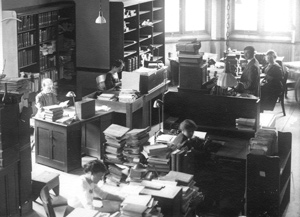 *
*
Like the decision to build the Regenstein, expanding its campus footprint underscores the library’s centrality to Chicago’s intellectual life. But, as Nadler observes, the planning process has changed as thinking about academic libraries in general, and the University Library in particular, has evolved.
The Reg began as one man’s vision (see “Central Force”) and with the assumption that if you plan it, funds will come. “Acquiring funds and capturing prime campus space” this time around, says Nadler, meant weighing and discarding a range of options, including cheaper off-site storage. And because the addition’s impetus was not a single person’s vision but a common need, “the expectation was that planning would be consultative, with much more involvement by all those who use the library,” she says. It’s an expectation she appreciates, having picked up the project reins from longtime library director Martin Runkle, AM’73, when he retired in September 2004.
The same consultative focus on users and their needs animates the library’s five-year strategic-planning process, now in its second year and encompassing all seven of the campus libraries. “Users are always the focus of a service organization,” Nadler says, but in recent years librarians have moved from “divining what the users needed” to “assessing what the readers want and why,” to understand not only how library materials are used but also “how the space is being used and continues to be used” (see “Heavy Connections”).
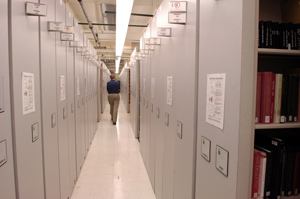
The Regenstein blueprint saw library patrons as scholars on individual intellectual odysseys and worked to remove barriers between user and materials—integrating once-scattered collections, improving access, and providing reading space. But in the age of digital information, online journals, and Google’s plan to create what it bills as a “virtual card catalog of all books in all languages,” individuals see libraries as only one port from which to embark. To continue to pull in users, Nadler says, planners must consider “the total place—aesthetics, amenities, ways of bringing the outside in and extending the inside out.”
The same concern, Nadler says, informs the report of the Provost’s Task Force on the University Library, to be released later this year. The faculty-written report, she says, calls upon the library to continue outreach to users in terms of both intellectual content and physical space: “If we truly are to become one of the few libraries in the country with such a large collection under one roof,” explains Nadler, “then scholars from around the world will want to come to us.” A library fellowship program, developed in partnership with academic departments and modeled along the lines of the Chicago Humanities Institute already housed in Regenstein, could support incoming scholars. In return, they would share their research through talks, workshops, and classes—all taught in the library.
GROUNDBREAKING FOR THE HELMUT JAHN-DESIGNED ADDITION along the Reg’s western edge will take place next autumn—not a moment too soon. With 150,000 volumes added to the collection each year, the compact shelving installed as a stopgap measure in the mid-1990s has almost reached its limit. Meanwhile the Law School has begun to renovate its central tower, transforming its library, as Law Dean Saul Levmore wrote alumni this spring, “from one designed largely as a book warehouse to one where students gather, ideas are exchanged, and wired and wireless connections give access to information.”
More room for interaction means less shelf space. Enter what Nadler calls “dark storage,” or interim off-site space. Although in a safe-preservation environment, dark-storage materials will be unavailable to users until they are moved back into the addition and so must be chosen with care (a faculty advisory committee helps make the decisions). Good candidates for dark storage include journals with full online equivalents and titles for which interlibrary loan agreements are already in place or can be easily arranged. By the beginning of August, 200,000 volumes from the D’Angelo Law Library had been packed and moved to the interim storage facility in Merriville, Indiana. In early September, 40,000 volumes from the Reg’s print collection (again chosen because they’re accessible by other means) had joined them, with another 100,000 volumes expected to follow by summer 2008.
At some point, Nadler acknowledges, shelving space will again run out: “Then we can move off-site. Ten million volumes under one roof is enough for anyone.”
Heavy connections
The more today’s Chicago students
use electronic research materials, the more they do research the old-fashioned way.
By Andrew Abbott, AM’75, PhD’82
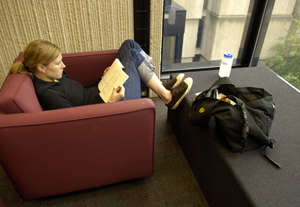
If you have been wondering for years whether it’s true that students make love in the stacks of Regenstein, I’m sad to say that I can’t tell you the answer. But I can tell you that more students take a nap in Regenstein than ask a librarian a question. I can tell you that almost a fifth of students eat food in Regenstein outside the café on most of their visits. And much more important, I can tell you that the electronic library revolution seems—paradoxically—to be raising rather than lowering usage of the library’s physical materials. All these are results of the 2005 survey of library usage conducted by the Provost’s Task Force on the University Library.
The task force, convened by Provost Richard Saller in April 2005, conducted the survey as part of its effort to understand the current state of the University’s libraries. Our aim in conducting a survey was not to plan the future by projecting current trends; our vision for the library’s future must rest on a theory of library research, not on rationalizations of current behavior. But Regenstein’s double function as both a major research library and a study hall for undergraduates and early-career graduate students means that any plans for the building must understand the behaviors of the nonresearch users as well as of the researchers.
Going into the survey, our thinking about student library use was guided by vague opinions and precise but hard-to-interpret utilization figures. Faculty opinion sensed a move toward informality. Many found Regenstein noisier, less welcoming. Some thought it a “student union.” Turnstile data revealed some striking shifts. Over the four-year period 2000–04, undergraduate entries to Regenstein were up 40 percent. To be sure, part of the rise reflected the College’s expansion and the building of a huge dormitory next door, but even controlled for demographic expansion, the undergraduate entry rate was up nearly a third. In contrast, undergraduate circulation rates had declined slightly. Graduate entry and circulation figures revealed no noticeable trends.
There is little detailed information on longer-term trends. We know that around 2,500 patrons per day used the library in the mid-1970s and that roughly the same number of materials were checked out then as now. Because there were half as many students, rates of use were obviously far higher in the mid-1970s. But by the mid-1990s—an era for which there is detailed information—use had fallen dramatically. One main culprit was the personal computer, whose immobility in the pre-laptop, pre-wireless era meant users tended to take research materials out (to the home or office where the machines were) rather than use them in the library. The other culprit was the coursepack (and later, electronic reserve), which reduced the reserve use that provided almost half of library circulation in the 1970s.
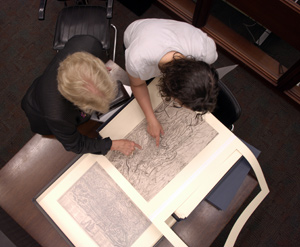
By 2005 it was apparent that usage of all kinds had picked up again. To analyze that usage, in spring 2005 the task force commissioned a Web-based survey, which was developed and administered by the University Survey Lab. The sample of 14,000 included all registered students across the entire University. Overall response was 42 percent—and well over 50 percent in the groups which turnstile evidence tells us are the library’s major users: students in the College and graduate students in the Humanities and Social Sciences. But there were plenty of nonusers in the data; nearly a quarter of respondents, for example, did not take a single book out of the library last year. Thus, the data seem to provide a reasonable representation of student library use and opinions.
Of the 5,700 respondents, about two-thirds named Regenstein as their most used library. Another 10 percent favored Crerar, 10 percent claimed no favorite, and the rest were scattered around the system. Of the 90 percent who named favorites, 15 to 20 percent said they had spent less than ten hours in their “most used” library during the entire spring quarter. In other words, about a quarter of all respondents had no real connection with a University library as a physical entity, although they may have used library-licensed electronic sources remotely. Indeed, only about 1,200 respondents said that their primary study space was Regenstein, as opposed to, say, another library or a coffee shop or their residence. Extrapolation suggests that the “primary study space” clientele for Regenstein is between 1,500 and 2,000 students—or considerably less than half of the University’s 4,500 undergraduates.
Under the admittedly lax ten-hour criterion, about 2,600 respondents called Regenstein their most used library, and nearly all the findings below are based on their answers. We asked dozens of questions about their usage of the library, as well as about their desiderata, their demographics, and so on. The main usage questions included 41 different types of activities. Participants were asked if they did these things never, sometimes, on about half their visits, on most of their visits, or on all visits.
To the extent that Regenstein is a student union, it is so at a time that doesn’t interfere with its research mission.
After much preliminary statistical analysis we grouped this information into eight major scales. Five were direct measures of library usage. A traditional research scale combined activities like checking out a book, browsing the shelves, using printed library material without checking it out, or using the online catalog. A second scale charted the use of online databases, while a third pulled together use of online resources like the Research Libraries Group catalog, Worldcat, bibliographic search engines, subject guides, and online reference works. A fourth scale tapped use of specialized resources: archives, special collections, microforms, and CD-ROM databases. The fifth measure looked at circulation, taking data directly from library records.
Because research is not the only use of the library, these scales were complemented by three others charting more mundane matters. One was a purely social scale: items about meeting new people and hanging out on A-level, the undergraduate study space that is a major campus social center after 10 p.m. Another scale comprised items about use of library computers for assignments. Finally, there was a scale originally imagined as an indicator of the library’s status as a student union. Students were asked if they used the library to take a study break, make a cell phone call, answer a cell phone call, arrange to meet a friend, bump into a friend and chat, use e-mail, eat food brought into the library, eat food bought in the library coffee shop, surf the Web, or shop on the Web. It was, in fact, a laundry list of things that many faculty considered antithetical to serious use of the library.
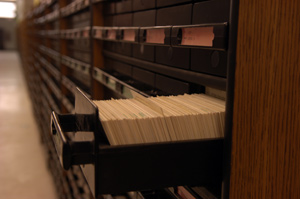
This “student-union” scale produced the first surprise. The task force had expected an inverse relationship between the student-union scale and the traditional research scale. But there was no relation whatever, at the individual level, between being high or low on the traditional research scale and being high or low on the student union scale. The scales measure different things. The first measures traditional research practices; the other measures what for Chicago’s current students—both graduate and undergraduate—is a particular way of doing everyday life. Choosing to arrange your everyday life in this technology-based, somewhat sociable way is unrelated to whether or not you are a strong or weak user of traditional research practices.
It followed that our model of “student union versus research facility” was also wrong. While there is a negative relation between the purely social scale—the A-level scale—and the traditional research scale, the library’s A-level, social side is essentially an evening affair, when, as the turnstile data demonstrate, faculty and even graduate students are simply not around. To the extent that Regenstein is a student union, it is so at a time that doesn’t interfere with its research mission. A kind of “temporal zoning” keeps the two uses out of each other’s way.
There was a distinct difference between research and study use. Using library computers for assignments was much more characteristic of undergraduates than of graduate students. Undergraduates were also much more likely to bring materials of their own (books, notes, etc.) into the library. By contrast, graduate students were much higher on the traditional research scales. These three facts made a single consistent point about research versus study.
One hesitates to underscore this contrast, for fear of showing once again that sociology is the science of demonstrating the obvious. But we should recall the old joke about the mathematician who spends two days proving that he was correct in his offhand statement that some step in a proof was intuitively obvious: it is better to be safe than wrong. So it is important that we can say on the basis of real evidence, not hearsay, that undergraduates predominantly—almost overwhelmingly—use Regenstein as a study hall, bringing material there and doing assignments there. Graduate students use it predominantly as a research site. This is not an absolute difference by any means, but it is a strong theme throughout the data.
The pattern is driven to a great extent by the College curriculum. Both the Core and much upper-level undergraduate teaching emphasize careful analysis of a small number of selected texts, usually purchased. Indeed, when looked at by College year, all of the research scales—traditional research, both electronic scales, circulation, and even special resources—jump up slightly from first- to second-year (as students move out of the full-time Core) and take a somewhat more substantial jump up from third- to fourth-year as the honors students write BA papers and finally have to dig into the library seriously.
Although early-stage graduate students echo the undergraduate pattern of bringing their own materials and using Regenstein as a study hall, most graduate student use is research: graduate students were a full point higher on the traditional research scale. This means they averaged a point higher on each of the scale’s eight items, where “a point higher” means the difference between “sometimes” and “about half the time” or between “usually” and “always.” It’s a big difference—one that holds up for circulation levels and for use of specialized resources. More important, the graduate students’ edge also held up for both online-database use and electronic-research use. Even though the undergraduates were much higher on electronic-database use than on any of the other electronic measures, the graduate students were higher still.
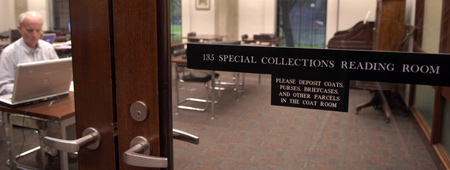
This means that there was no evidence that younger people were somehow “more electronic.” Graduate student respondents, after all, averaged eight to ten years older than College respondents. Yet they made more use of electronic resources. And, as we saw earlier, they were also equally likely to conduct everyday life electronically.
The research-use data provide the surprising conclusion to this syllogism. The more an individual uses books, the more he or she uses electronic-research resources, and vice versa. The finding holds not only at the group level—graduate students are higher on both scales—but also at the individual level. This seems like very strong evidence in favor of a synergy hypothesis—that use of one of type of material is likely to reinforce the use of the other. At the very least, the survey data provides no evidence that traditional research practices are being replaced by electronic ones. Thus, the replacement hypothesis—a standard idea in library literature—must be rejected.
Hits on the library’s licensed electronic databases do show the one grain of truth in the mountain of the replacement falsehood. The main electronic workhorses—receiving the majority of total hits—are JSTOR and Elsevier Science Direct, which are merely delivery systems for journals. What’s being replaced is one type of material (journals) and that only in the final delivery stage: now people find journal articles online and print them directly. We know that users make hard copies, by the way, because more than half of all JSTOR hits result in a printing. At least in the humanities and social sciences, neither faculty nor students seem to read articles on screen.
THE DISCUSSION SO FAR CONCERNS LARGE CATEGORIES OF USERS—undergraduates, graduate students in this or that division. But there is much variation within these categories. It is clear from the survey—as from circulation data—that research use of the library is heavily skewed. Asked by the provost to facilitate the research enterprise, the task force had to ask in turn, Who, really, are the constituents of that enterprise, the heavy users of the library?
Gross circulation figures (from 2003–04) give some sense of who these heavy users are. Out of some 33,000 cardholders, about 13,600 “users” actually took out at least one book. About ten percent of those users provided 50 percent of all circulation. At the other end of the scale, the lowest 50 percent of users provided only 10 percent of the circulation. (Remember, this definition ignores cardholders who didn’t take out a book—a group that includes one quarter of Chicago undergraduates in a given year.) Basically, the library’s heavy users in circulation terms are the approximately 1,000 people (7 percent of the total users, 3 percent of all cardholders) who take out more than 100 books a year, providing close to 40 percent of all circulation. This group included about 80 faculty, about 500 PhD-level graduate students, about 100 MA-level graduate students, and about 140 undergraduates.
But the survey offered a more detailed way to characterize the students among these heavy users. We took our “never” to “always” scales, lumped together the top two categories—“usually” and “always”—and called that heavy use. We lumped the bottom two categories—“never” and “sometimes”—and called that light use. We left the middle as medium use. For circulation, we called 100-plus heavy use and 50-plus medium use. This created low, medium, and high ratings for each of our five research scales—traditional research, circulation, other resources, electronic databases, and general electronic sources. People with high levels on more than one scale were our student “heavy users.”
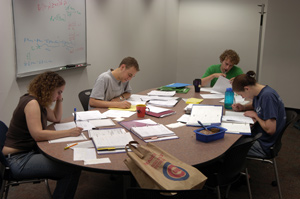
Believe it or not, 13 student respondents ranked high on all five scales. Another 56 rated high on four out of five; 163 on three of five, and 330 on two of five. This makes a total of 562 “heavy users” on two or more scales. In rough terms, Divinity School graduate students are 7 percent of these, social-sciences graduate students about 30 percent, humanities graduate students just under 50 percent, and undergraduates about 12 percent. Thus, although their rate of heavy-research use is quite low, the sheer numbers of undergraduates mean that they still make a significant contribution to the library’s heavy-user population. As a result, the library staff has to serve three very different types of heavy user—faculty, graduate students, and undergraduates.
As we saw earlier, these heavy users pursue their work in a library that is mostly filled with students using Regenstein as a study hall. But observational studies sponsored by the task force make it clear that study and research use live together in surprising harmony. Even at its heaviest use—just before exams when a third or more of the seats in Regenstein are occupied—the building is remarkably quiet and orderly, especially as one gets further away from the first-floor entry space. And fortunately, many of the things that can be done to improve Regenstein’s utility for its heavy users can be done without impairing its utility as a study hall for the perhaps 1,500 undergraduate and early graduate nonheavy users for whom it is their principal place to do assignments.
The task force went into its study knowing about the differences in graduate and undergraduate use and the largely graduate nature of the heavy-user community. But the noncorrelation of a student’s electronic everyday life with his or her research practices surprised most of us, and the powerful positive correlation between electronic- and traditional-research practices was quite unexpected. Such findings underscore the need to plan the library’s future not by extrapolating trends or imagining a speculative techno-utopian facility, but by thinking long and hard about the library-research process, the library-research community, and the specific ways in which both can be helped by a transformation of the library that has served the University so well for so long.
Andrew Abbott, AM’75, PhD’82, the Gustavus F. and Ann M. Swift distinguished service professor in sociology and the College, chaired the Provost’s Task Force on the University Library. His mother was a librarian.
Central force
Chicago began
life with one of the nation’s largest university libraries. all
it lacked was the physical structure to house the collection. Here’s
why the reg wasn’t built in a day.
By Neil Harris
Regenstein Library’s fall 1970 opening was the critical linchpin in the reconstruction of the University after decades of challenge. Planning and building were acts of faith and assumptions of risk. While many were involved, one person, above all others, got the structure built, got it built where it stands, and got it built in its final form: Herman Fussler, AM’41, PhD’48, library director from 1948 until 1971. Reviewing the reports, correspondence, studies, consultations, manifestos, promotional appeals, and commentaries produced over several decades inspires respect for his lengthy, highly personal, and ultimately victorious campaign to build a great central library reflecting the aspirations of the institution.
The search for a physical structure to house what had suddenly become, in the 1890s, the nation’s fifth largest university library, began, however, long before Fussler’s arrival, emerging as a major theme during Chicago’s first 20 years. A celebrated, if flamboyant, gesture, the purchase from a German dealer of the so-called Berlin Collection—some 175,000 books, including rare historical, classical, and philological works—when added to materials inherited from the first University of Chicago, created an important, if uneven, nucleus for scholarly research. But no major library building was planned, both for financial and intellectual reasons. Scientists wanted their laboratories and museums. Humanists and social scientists wanted their seminar rooms, with ready access to specialized collections. For decades they opposed the centralizing efforts of librarians, administrators, and colleagues with an intensity unsurprising to students of academic warfare.
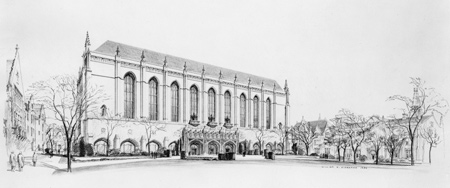
*
Despite occasional hints at massive building plans, the library spent ten years in a temporary structure on what is now Hutchinson Commons, sharing space with a gymnasium and a bookstore. In 1902 it was moved to the new University Press Building, on 58th and Ellis, where it remained, augmented by collections in Cobb and later Haskell, for another ten years. Although President Harper had hopes for a large new building, it was, in fact, his death in 1906, and the need to provide a suitable memorial, that stimulated a $600,000 gift from John D. Rockefeller, supplemented by other donations, and produced the $1 million Harper Memorial Library.
Harper would be Chicago’s central library for 58 years, but its glaring deficiencies constituted a warning about the consequences of poor physical planning, an unhappy revelation of how things could go very wrong. Not that Harper wasn’t, and isn’t, beautiful. The entries, facade, and reading rooms were adorned with sculpted references to the University’s mission, to the power of print, and to collegial institutions. The elegant main reading room remains a powerful presence. This was a monument.
Harper Memorial Library, however, was meant to be part of a vast multibuilding complex. This had been the plan ever since 1902. History and social sciences to the east; humanities, including classics, to the west; theology and law to the north—all connected by bridges or tunnels. The first two floors, under the main reading room, were to be filled with stacks, to house the growing collection.
But plans and reality did not match. It took a decade more for the two adjacent structures—Wieboldt and Social Sciences—to be completed; not all bridge connections were made; the floors below the reading room became offices, and the building’s narrow footprint, plus the difficulties of expansion, intensified issues of book delivery, communication, and movement. Despite the almost immediate openings of Classics and Rosenwald, each with extra stack space, within a decade after its ceremonial inaugural Harper was deemed impossibly overcrowded. When it opened in 1912 its capacity stood between 500,000 and 600,000 volumes. But the collections already approached the 500,000-volume figure. By 1924 half of the University’s books were housed in departmental libraries.
Meanwhile, with help from wealthy philanthropists, the University made impressive additions to its collections, maintaining its No. 5 rank among American university libraries. During the late 1920s, moreover, M. Llewellyn Raney, the first professional librarian to be appointed library director, arrived from Johns Hopkins, and the graduate library school was soon established.
By 1922 a faculty and trustee Commission on the Future Policy of the Libraries had been established in response to the perceived crisis. It came up with two diametrically opposed views—a decentralized, department-oriented system, favored by many faculty, especially the scientists, and a new central library. The architectural firm Coolidge & Hodgdon drew up plans for such a central building, just opposite Harper, creating a library court, incorporating Haskell and the Law School. But in classic fashion, unable to reach consensus, the commission voted to postpone action on either proposal. In 1930 the issue was raised again, only to be sidetracked by the Depression.
Remedial steps were indeed taken. New stacks were built, efficiencies introduced, but World War II postponed further action. By 1950 the only way that the University could receive more books was to get rid of old ones. A double strategy was adopted: sending more and more books to the new Midwest Inter-Library Center (today’s Center for Research Libraries, located south of the Midway at 6050 South Kenwood Avenue), and microfilming as much as possible. Fussler—who had joined the staff in 1936, coming from the New York Public Library to head the photographic-reproduction office—admitted that both were limited, short-term strategies. Soon after his appointment as director and the creation of a faculty-trustee committee headed by President Harper’s son, Paul Harper, AB’08, JD’13, plans were drawn up for a new central library, in both Gothic dress and modern garb. Slated for the site occupied by tennis courts, facing University Avenue at 58th Street, the building would balance the new Administration Building on the quadrangle’s western edge. Fussler developed a detailed scheme that he eagerly shared with an ongoing, multiuniversity Committee on Library Building Plans. In December 1949, anticipating what would come 15 years later, he and architect William Alderman showed the group several floors of a proposed 400,000-square-foot library.
Fussler was ready to move, but no one else was. As he noted, despite trustee committees on library development, there seemed little commitment to the task. University fund-raising campaigns did not feature the library’s needs. “I think it fair to say,” he wrote in 1956, “that until at least the last year or two before he resigned Mr. Hutchins was not convinced that major new library construction was a matter of critical importance to the current and future well-being of the University. I think he may have had this conviction when he left, but I am not positive.”
During the early 1950s, as Hutchins’s successor, Chancellor Lawrence Kimpton, focused on the neighborhood and urban renewal, Fussler continued to write memoranda, issue warnings, appeal for faculty support, and urge the trustees to pay concentrated attention to the need for a new facility and for a larger, better-paid staff. His evidence and logic were compelling, and his rhetoric eloquent, but neither got very far. The library’s decline, relative to other institutions, was now absolutely clear, and the overcrowded, outdated facility was an embarrassment for recruitment purposes. By the late ’50s library expenditures had slipped to 20th among American universities, and its size was in danger of dropping from the top ten.
Kimpton at last recognized the situation’s gravity, and in 1959–60 a Chicago architectural firm, Pace Associates, was hired to consider proposals to address the problem. One involved a $5.5 million reconstruction, keeping Harper but adding to its north frontage, taking down Haskell and constructing a building connected to Harper—essentially doubling its capacity. The second possibility, which appealed more to Fussler, would have cost twice as much, and created a completely new building, presumably on the tennis courts. But again no decision was made.
The big shift came with the 1961 arrival of George Beadle as president and the simultaneous appointment of Edward H. Levi, PhB’32, JD’35, as provost. The Beadle-Levi duo, with Fussler and trustee Gaylord Donnelley, became the promotional team, making a new library an essential component for their vision of the future—the reinvention of the University of Chicago, the stabilization of the neighborhood, a return to financial solvency, and new ambitions for rebuilding and enlarging both the faculty and the student body. Fussler and his allies lobbied the faculty to cultivate support, to design the library’s program, and to restart the quest for funds. In 1962 the trustees and the Committee of the Council formally committed themselves to a new central library, and planning, conceptual and architectural, for what would become Regenstein began.
By now, Chicagoans had been thinking about a new library for some 40 years, and Fussler had been drawing up plans since at least 1949. His interest was creating a library primarily for the research needs of faculty and graduate students. In autumn 1964 the College contained only 2,146 undergraduates, fewer than half the present enrollment, while the humanities and social sciences divisions, plus graduate education and the graduate library school, contained more than 1,900; the entire university consisted of just 6,900 students, although enrollment was projected to rise to more than 10,000, including 4,000 graduate students, within ten years.
In early fall 1962 Fussler and University Architect Lee Jones set about searching for an architectural firm. A series of famous names surfaced, including Philip Johnson and Louis Kahn, but in the end the focus was on architects with experience designing large research libraries. In late 1962 Fussler and Jones visited four firms, recommending three to the board. Fussler’s first choice was Skidmore, Owings and Merrill (SOM) of Chicago, and Walter Netsch in particular, creators of the Crerar Library at the Illinois Institute of Technology; the University of Illinois at Chicago campus and its library; and the Northwestern University library. Fussler was not uncritical of Netsch’s work, observing that the architect needed to be supervised closely, but he valued his previous library designs and wanted a Chicago-based architect. Whether he ever came to regret the decision is unclear, although there were tensions as he tried to wean Netsch away from his heavy reliance on the Northwestern plan, with its separated towers, which he considered unsuitable for Chicago.
By mid-1963 it became apparent that a 3-million-volume library, of almost 500,000 square feet, could not be built atop the old tennis courts. Even without the science collections it would either be too tall, marring the central quadrangles, or have too many operations below grade. Parking and delivery would be difficult and expansion expensive. Harper had demonstrated the folly of accepting an inadequate footprint, and so in October 1963 Fussler went to a joint meeting of the Board of the Library and the Faculty Library Committee, asking them to endorse a move further north, to Stagg Field. They did so unanimously. Professor Robert Grant of the Divinity School, Fussler reported wryly, stated that his faculty “had formally indicated that they were capable of walking from Swift as far as the tennis courts, and he was confident that they could also make it to Stagg Field without serious hardship.”
Stagg Field had long been seen as usable ground for campus add-ons. At one point it was to take in the dormitory later known as Woodward Court; Eero Saarinen, the University architect during the ’50s and early ’60s, drew up high- and low-rise dormitories covering most of the site. Yet Woodward went to Woodlawn Avenue, and Stagg Field remained ripe for the plucking. Half the size of the main quadrangles, with their two-dozen buildings, the area housed just the athletic field, Bartlett, and some outbuildings. It was too far from the labs and medical school for a science library, but that flaw could be addressed.
Now the physical planning could get serious. During 1963 and 1964 Fussler worked almost continuously with the library board and a special faculty library committee. Throughout the project, the committee would provide a creative, critical, and ultimately supportive sounding board.
Where would smoking be allowed? How would the noise of typewriters be cushioned, if students or faculty used them for note-taking? Did we need a full-service canteen? How cold would the stacks be?
The faculty committee met for the first time on March 12, 1963. In an extended, lively session, attended by five members of SOM, along with staff members, President Beadle, Provost Levi, and ten faculty, Fussler outlined the project’s underlying assumptions. There would be two central libraries, with a science library, located near 58th Street and Ellis Avenue, to be constructed after the humanities-social sciences building was completed. The new building would be layered horizontally: subject-oriented reading rooms, bibliographers, and service facilities located on each floor, just outside the relevant stacks.
Fussler argued for dramatically separating study facilities from the stacks, partly to control the movement of books through the enormous building. Reversing a 50-year-old trend within American university libraries of inserting more study space within the stacks, this was a controversial position. He noted multiple advantages: lower stack temperatures, inhibiting the physical deterioration of book paper; reduced traffic; and, via the dedicated reader areas, promotion of group identity among graduate students.
It is impossible to overestimate the concerns about book security and controls expressed by both faculty and librarians. In response, Fussler pointed out that charging areas outside each stack floor and entry controls would keep books from being dispersed, uncharged, through the building. Some committee members observed that the heaviest users, faculty working in their studies, would be farthest from the stacks. Others wanted more desks and even carrels in the stacks, arguing against the lockable shelves Fussler favored in the reading areas, lest too many books be removed from circulation. While Fussler insisted lockable shelves be provided, he did not want assigned seating or study spaces for researchers—except for the faculty studies. In the end, consultation desks along the stack perimeter seemed to meet the need, and in several votes faculty accepted the larger scheme. In another response to faculty argument, enclosed rooms for groups of 12 to 15 to work in, within the reading areas, created potential seminar or class space.
At this first meeting, Fussler also argued that the new library must encourage experimentation, even while acknowledging that a functioning institution had to accept most existing conventions. Yet the notes reveal that Provost Levi not only endorsed experimentation but also declared the Fussler plan more conventional than he had expected. Suggesting fresher, technologically oriented approaches, Levi observed it might be possible to put the card catalog and many books on tape, providing places where they could be read through closed-circuit TV and other devices—comments both revolutionary and prophetic in 1963. Fussler and his library colleagues responded that they expected traditional uses to coexist with changes still unborn, but Levi pressed back, stressing his hope that “the library will be like a good hospital—always experimenting, always seeking new and improved techniques.”
Every part of Regenstein was similarly scrutinized, debated, and not set aside until consensus was reached. In May 1965, after final plans were drawn, Fussler invited librarians from Cornell, Michigan, and Harvard to Chicago, imploring them to critique his approach. Fearing some punches had been pulled out of courtesy, he requested a second report from Cornell’s librarian, Stephen A. McCarthy, PhD’41. McCarthy responded with a thorough critique, suggesting three more floors—“Netsch will kill me for this one” he noted—and a cube-like structure. “You may be sorry you asked the question,” he wrote Fussler. “If you are, just tear this up.” Fussler kept the report, but McCarthy’s suggestions came to naught. Nonetheless, a special faculty subcommittee was created to encourage continuing debate.
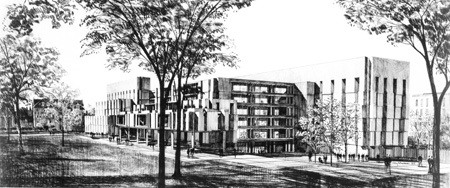
*
The planning proceeded with many questions, some of which time has transcended. Where would smoking be allowed? How would the noise of typewriters be cushioned, if students or faculty used them for note-taking? Would checking books out on each floor distract reader concentration? How cold would the stacks be? Would that discourage browsing? Did we need a full-service canteen? How large should the reference collections be on each subject-themed floor? What size reading tables were best, and were dividers appropriate for reader territoriality? How would the floors, particularly the first floor, be covered? Carpeting was meant to soften noise levels and enhance physical appearance, but old-timers will remember the damage inflicted on the solid-color carpeting by a single Chicago winter. How should current serials be housed—in one single supervised section, or divided, concentrated on the second floor, but with hundreds of others placed near their various specialties? Would art and music enter the main library or be housed elsewhere?
Meanwhile the architects sought to break up the mass of what would be by far the campus’s largest building and set it back from the bordering streets. However useful an aesthetic, and even symbolic, decision, it would vastly complicate later efforts to develop the north campus, and almost irretrievably challenge the quadrangular scheme that had been the basis for the old campus. But within months a plan was arrived at.
What remained was the money, and this was no little thing. Tentative costs, by early 1964, worked out to $17 million. Actual costs would be closer to $20 million. This was a huge sum—by CPI calculations in today’s dollars $130 million, but probably even more given construction costs—and for a while suggestions were made to reduce the size of the structure or divest it of certain functions. These were ultimately rejected. A major request to one foundation resulted in a rather curt turndown. There were continuing discussions of possible donors or honorees who might inspire donors, but nothing came of this. All that had been accomplished, after several years of work, was a planning grant of $500,000 and some contributions totaling $80,000.
Then, on November 9, 1965, just 20 days after the University launched a three-year, $160 million campaign, the Regenstein Foundation awarded a $10 million gift for the building, and the University presented its plan, along with pictures of the new baby, to the public. Seven months later, in June 1966, a $3.5 million grant from the Department of Health, Education and Welfare completed the major funding. After more than 75 years of debate and frustration, the University of Chicago would finally have a well-planned, central research library. Fussler, his mission accomplished, would take up a full-time professorial post in the Graduate Library School, where for the next 12 years he would watch Regenstein become a model research library for the humanities and social sciences—and a leading force in the University’s intellectual life, a role it continues to play.
Neil Harris, the Preston & Sterling Morton professor in history, art history, the Committee on Geographical Studies, and the College, calls himself “an old library complainer but a fervent library supporter.”